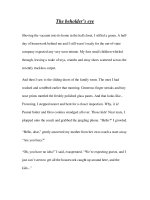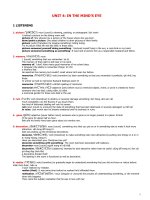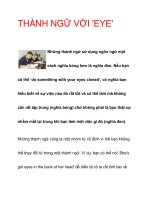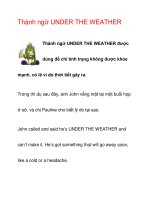eye wonder weather
Bạn đang xem bản rút gọn của tài liệu. Xem và tải ngay bản đầy đủ của tài liệu tại đây (14.6 MB, 48 trang )
Terrifying tornados, huge hurricanes,
and scorching sunshine!
Look to the skies and discover the amazing
power and beauty of the weather, and how
it affects our lives.
¥
Packed with facts and dramatic photographs,
Eyewonders are the perfect way to inspire a
love of learning and discovery.
Consultant Ben Morgan is a science writer who has produced several books for
children including the DK Guide to Mammals and Human Body Revealed.
Look out for other titles in the Eyewonder series:
Big Cats ¥ Birds ¥ Bugs ¥ Dinosaur ¥ Dolphins & Whales
Earth ¥ Human Body ¥ Mammals ¥ Ocean ¥ Rainforest
Reptiles
¥
Rivers and Lakes ¥ Space ¥ Volcano
Jacket images Front: Getty Images: Taxi. Back: Alamy Images: Bryan &
Cherry Alexander Photography (bl). Corbis: Tom Bean (br). Getty Images:
Stone (cr); Taxi (tr), background. Planetary Visions: (tl). Science Photo
Library: British Antarctic Survey (clb); Claude Nuridsany & Marie Perennou
(cra); Colin Cuthbert (tc); Jim Reed (cl); R.B.Husar/NASA (cla).
Discover more at
www.dk.com
DORLING KINDERSLEY
EYEWONDER WEATHER
Terrifying tornados, huge hurricanes,
and scorching sunshine!
Look to the skies and discover the amazing
power and beauty of the weather, and how
it affects our lives.
¥
Packed with facts and dramatic photographs,
Eyewonders are the perfect way to inspire a
love of learning and discovery.
Consultant Ben Morgan is a science writer who has produced several books for
children including the DK Guide to Mammals and Human Body Revealed.
Look out for other titles in the Eyewonder series:
Big Cats ¥ Birds ¥ Bugs ¥ Dinosaur ¥ Dolphins & Whales
Earth ¥ Human Body ¥ Mammals ¥ Ocean ¥ Rainforest
Reptiles ¥ Rivers and Lakes ¥ Space ¥ Volcano
Jacket images Front: Getty Images: Taxi. Back: Alamy Images: Bryan &
Cherry Alexander Photography (bl). Corbis: Tom Bean (br). Getty Images:
Stone (cr); Taxi (tr), background. Planetary Visions: (tl). Science Photo
Library: British Antarctic Survey (clb); Claude Nuridsany & Marie Perennou
(cra); Colin Cuthbert (tc); Jim Reed (cl); R.B.Husar/NASA (cla).
Discover more at
www.dk.com
DORLING KINDERSLEY
EYEWONDER WEATHER
Eye Wonder
First American Edition, 2004
Published in the United States by
DK Publishing, Inc.
375 Hudson Street
New York, New York 10014
04 05 06 07 08 10 9 8 7 6 5 4 3 2 1
Copyright © 2004 Dorling Kindersley Limited
All rights reserved under International and
Pan-American Copyright Conventions. No part of this
publication may be reproduced, stored in a retrieval
system, or transmitted in any form or by any means,
electronic, mechanical, photocopying, recording or
otherwise, without the prior written permission of the
copyright owner. Published in Great Britain by
Dorling Kindersley Limited.
A Cataloging-in-Publication record for this book is
available from the Library of Congress.
ISBN 0-7566-0323-4
Color reproduction by Colourscan, Singapore
Printed and bound in Italy by L.E.G.O.
Discover more at
www.dk.com
Written and edited by Lorrie Mack
Designed by Cheryl Telfer
and Helen Chapman
Publishing manager Sue Leonard
Managing art editor Clare Shedden
Jacket design Chris Drew
Picture researcher Sarah Stewart-Richardson
Production Shivani Pandey
DTP designer Almudena Díaz
DTP assistant Pilar Morales
Consultant Ben Morgan
4-5
What’s weather?
6-7
The seasons
8-9
The power of the Sun
10-11
Clouds in the sky
12-13
Cloud gallery
14-15
Living in a cloud
16-17
Rain, rain
18-19
White skies
20-21
Icy showers
22-23
Dew and frost
24-25
Blowing in the wind
26-27
Electric skies
LONDON, NEW YORK, MUNICH,
MELBOURNE, and DELHI
Contents
28-29
Terrible twisters
30-31
Deadly storms
32-33
Tricks of the light
34-35
Out at sea
36-37
Desert worlds
38-39
Weird weather
40-41
Weather forecasting
42-43
Changing climates
44-45
Harnessing weather
46-47
Glossary
48
Index and
acknowledgments
Thin skin
If the Earth were a huge apple,
the whole atmosphere would be
thinner than the skin. Driving
straight through all its layers
in a car, you would reach
outer space in about
three hours.
“Weather” is what the sky and the air
outside are like—cloudy, snowy, sunny,
or windy. A wide band of air—the
atmosphere—surrounds Earth, but
weather only happens near the
ground, below the cloud tops.
This area is called the cloud
layer or troposphere.
What’s weather?
•
Together, energy from the Sun and
moisture in the air create our weather.
•
The air has lots of moisture in it
because water covers 75 percent of
Earth’s surface.
•
Weather kills more people than any
other other natural force on the planet.
Weather facts
The clouds that
constantly swirl
around Earth
are clearly visible
from weather
satellites in space.
Troposphere
Stratosphere
Mesosphere
Thermosphere
Aurora
(polar lights)
Meteor trails
Spacecraft
All our weather goes on in the layer of the
atmosphere closest to Earth—the troposphere.
Satellite
Outer space
5
Out of this world
Above the troposphere is the
stratosphere. Here, because the
air is very dry, there is no
rain or wind. Pilots like
to fly at this level
because they can
be sure of a
smooth ride.
Every day, we live with
one of the most powerful
natural forces of all—
our weather.
s
u
n
r
a
i
n
s
n
o
w
When an airplane flies
above the clouds, the
passengers have a
magical view from
the windows.
w
i
n
d
f
r
o
s
t
When one part of the world is basking
in summer, another part is shivering
in winter. This happens because Earth,
which leans to one side, travels on a
long journey around the Sun.
On the tilt
Earth is a round ball with
an imaginary stick, or axis,
running through the center
(dotted red line). This axis is
tilted so one half of Earth gets
more sunlight than the other
at any one time, and is
therefore sunnier.
June
The northern hemisphere is tilted toward
the Sun, so the people there are enjoying
summer. South of the equator, there is
much less sun, so winter is setting in.
March
It’s spring in the northern
hemisphere, and fall at
the other end
of the world.
The seasons
North and south
The equator is an
imaginary ring around
Earth’s middle (yellow
line). The area above
it is called the northern
hemisphere, while the
area below it is the
southern hemisphere.
6
A
y
e
a
r
h
a
s
3
6
5
d
a
y
s
b
e
c
a
u
s
e
E
a
r
t
h
Ball of fire
The Sun is a fiery star made
of burning gas. We depend
on it for light, heat, and
energy. Without the
Sun, there would be
no life on Earth.
S
P
R
I
N
G
F
A
L
L
Axis
W
I
N
T
E
R
S
U
M
M
E
R
Equator
Constant heat
The places near the
equator are always sunny,
so the temperature is
warm all year.
December
In December, the northern hemisphere leans
away from the Sun, so it’s winter there. But
the Sun is stronger down south, so it’s summer.
September
September brings fall
to the northern
hemisphere, and
spring to the
southern hemisphere.
7
t
a
k
e
s
t
h
i
s
l
o
n
g
t
o
g
o
a
r
o
u
n
d
t
h
e
S
u
n
.
T
h
e
r
e
a
r
e
2
4
h
o
u
r
s
i
n
o
n
e
d
a
y
.
N
I
G
H
T
D
A
Y
DAY AND NIGHT
As well as moving
around the Sun, Earth
turns once on its axis
every 24 hours. We have
day and night because
different sides of it face the
Sun at different times.
F
A
L
L
W
I
N
T
E
R
S
U
M
M
E
R
S
P
R
I
N
G
8
Earth is constantly bombarded with rays from the
Sun—a huge ball of burning gases in space. As
well as producing heat and light, the Sun controls
Earth’s weather.
The power of the Sun
Warmth and water
Heat from the Sun turns
the moisture from leafy
trees and plants into
invisible water vapor in
the air. The same thing
happens with the water
in lakes and oceans.
Clouds
Moisture hovers in the
sky in the form of clouds.
When the clouds get full,
the tiny droplets in them
stick together and
become drops of rain.
Water sometimes
disappears into the
air and becomes
water vapor. This
process is called
evaporation.
9
Wind
The Sun’s rays warm pockets
of air, which causes them to
rise. Cool air then rushes in to
fill the gap. This movement
of air is what we call wind.
Rain
Water from clouds falls as rain.
If the air is cold enough, the
moisture turns into snowflakes
instead of raindrops. Whatever
form it takes, all moisture that
falls to the ground is called
precipitation.
Starting again
Some rain and melted snow flow back into our
rivers and oceans. This water is called runoff.
Soon it will evaporate into clouds again.
•
If all the Sun’s energy could
be harnessed for one second, it
would power the United States
for 9 million years.
•
Earth is a tiny dot compared
with the Sun, which is big
enough to swallow our planet
a million times.
Sunny facts
10
Clouds in the sky
Stratus
Of all the main types, stratus clouds
are lowest in the sky. Sometimes they
sit right on the ground to form fog.
Although stratus means “layer,”
the layers aren’t always clear—
often, stratus clouds
just make the sky
look gray.
Clouds are made from drops of water. The
amount of water in each cloud, its height, and
the air temperature determine what kind it is.
There are three main types—stratus, cumulus,
and cirrus—and lots of combinations of these.
•
In Latin, stratus means layer, cirrus
means hair, and cumulus means heap.
•
Clouds that have “nimbus” or “nimbo”
in their name are rain clouds.
•
Clouds that have “alto” in their
name form at a medium height.
Cloudy facts
Cumulus
These clouds are plump and
fluffy like cotton balls. Small
white ones appear on clear,
sunny days, but cumulus
clouds that are big and black
(called cumulonimbus) mean
rain or snow storms are on
the way.
Stratocumulus clouds
have layers as well as the
bumpy surface of cumulus
clouds. Their soft gray
shapes often produce
drizzle or light rain.
Sky map
Clouds are named according to
their height and how they’re
formed. Even those that
look quite similar can
have different names
at different heights.
Cirrocumulus clouds are a cross between cirrus
and cumulus types. When their regular waves of
tiny cloud clumps form a pattern that looks like
fish scales, we call this a “mackerel sky.”
Cirrus
High, wispy, feathery clouds
are called cirrus. Here, the air
is so cold that clouds are
made from ice crystals
rather than water
drops. Sometimes,
strong winds blow
them into long
strands or “mare’s
tails” because they
look like horse’s tails.
Nimbostratus
Stratus
Cirrocumulus
Cirrostratus
S
o
m
e
c
u
m
u
l
o
n
i
m
b
u
s
c
l
o
u
d
s
a
r
e
7
m
i
l
e
s
(
1
1
k
m
)
t
a
l
l
.
Altostratus
Airplane contrail
Cumulus
Stratocumulus
Cumulonimbus
Cirrus
12
There is nothing unusual about cloudy
skies—most of us see them all the time.
But we might be surprised if the clouds
looked like flying saucers, sheets of water,
or clusters of colored lights.
Human-made clouds
When jet planes crisscross the
sky, they leave behind long,
straight tails of vapor that
look like clouds. These are
known as contrails.
Painted clouds
When sunlight passes through the water
droplets or ice crystals in a cloud, it can
produce beautiful shimmering colors.
Wavy nights
Clouds that appear at night
and look like waves on the sea
are called noctilucent clouds.
The name “noctilucent” comes
from the Latin words for
“night” and “shine.”
Cloud gallery
Against a blue sky,
contrails sometimes
look like city streets
made of clouds.
13
Bumpy warning
The peculiar rounded shape of these
storm clouds gives them their name.
They’re called mammatus clouds, from
“mamma,” the Latin word for “breast.”
Mammatus
clouds are
often a sign
that there’s a
tornado on
the way.
A
l
l
t
h
e
s
e
b
u
m
p
s
a
r
e
c
a
u
s
e
d
b
y
d
o
w
n
d
r
a
f
t
s
o
f
a
i
r
.
Flying clouds
Lenticular clouds got their name
because they look a little like
lenses, but some of them look
more like flying saucers!
S
a
u
c
e
r
-
s
h
a
p
e
d
c
l
o
u
d
s
c
a
n
“
h
o
v
e
r
”
f
o
r
h
o
u
r
s
.
Rolling in
When warm, damp air blows over
cold land or a cold ocean current, its
moisture turns into fog. This type is
called advection fog.
The Golden Gate Bridge
in San Francisco is often
surrounded by fog.
Sometimes it’s so foggy outside, you feel
as if you’re walking through a cloud. In
a way, you are! Fog is actually a cloud
that is sitting on the ground instead of
floating in the air. There are several
different ways fog is made.
Living in a cloud
m
i
s
t
i
s
j
u
s
t
f
i
n
e
r
a
n
d
l
i
g
h
t
e
r
Experts describe fog in terms
of “visibility”—how far you
can see through it.
•
In ordinary fog, you can see
for about 1,100 yd (1000 m).
•
In thick fog, you can only
see 55–220 yd (50–200 m).
•
In dense fog, you can see
for less than 55 yd (50 m).
Foggy facts
M
i
s
t
a
n
d
f
o
g
a
r
e
d
i
f
f
e
r
e
n
t
t
y
p
e
s
o
f
14
Hazy days
When the ground loses
(radiates) heat and gets
very cold, it cools the air
above it, making water
vapor condense into fine
droplets. This creates the
most common type of fog,
known as “radiation” fog.
Mountain mist
On wooded hills,
moisture given off by
trees turns into fog
during the night. By
dawn, it has settled into
the valleys below. Later,
when the Sun warms
the air, this moisture
evaporates, and
the fog clears.
Poison air
When fog combines with
smoke, it forms heavy, smelly
air. Years ago, London,
England, had fogs so thick
that people called them
“pea-soupers.” This fog came
from the dirty coal fires that
heated most buildings. Today,
similar conditions, known as
smog, are caused by pollution
from cars and factories.
t
h
a
n
f
o
g
.
t
h
e
s
a
m
e
t
h
i
n
g
—
15
How much rain?
Scientists measure rain in a simple
gauge set into the ground. After
the drops fall through the funnel
at the top, they are
collected in the main
cylinder below.
17
Clouds are made of tiny droplets
of water. When a cloud takes
on more and more moisture, the
droplets get bigger. Eventually,
they get so heavy that they fall to
the ground as drops—small ones
are called drizzle, and big, heavy
ones are called rain.
Rain, rain
•
On the Hawaiian island
of Kauai, there are only about
15 days in the year when it
doesn’t rain.
•
Drizzle falls more slowly
than rain, since it is much
finer. It takes about 700 drizzle
drops to make one raindrop.
Rainy facts
Poison rain
When chemicals pour into the air from
factories and cars, they react with water
vapor to form harmful acids. The result—
acid rain—kills forests, poisons water,
and even wears away stone.
Falling shapes
Most people think
raindrops are shaped
like teardrops, but they
actually look more
like squashed buns.
Deadly showers
Heavy rain can cause terrible floods that
destroy life and property. When storms hit the
Zacatenco River in Mexico, its raging waters
had enough power to bring this bridge down.
Scary skies
Rain clouds hold a huge amount of
water, which makes them so dense
that light can’t get through. This is
why they look dark and scary. The
heaviest rain falls from the biggest,
blackest clouds.
New raindrops are round,
but they flatten out
gradually as they fall.
Arica, Chile
0.03 in (7 mm)
Kauai, Hawaii
460 in (11,680 mm)
New York
44.5 in (1,130 mm)
London, England
24 in (610 mm)
Berlin, Germany
23 in (580 mm)
Cairo, Egypt
1 in (25 mm)
Average
yearly rainfall
18
When the air is cold, the
moisture in clouds freezes into
ice crystals without turning
into rain first. These crystals
stick together and float to
the ground as snowflakes.
White skies
Swirling curtain
When snow is coming down thick and fast, we call it a
blizzard. Sometimes, even when a blizzard is over, wind whips
up the snow on the ground so it seems like it’s still falling.
In a really bad blizzard,
people can hardly see
where they’re going.
There can be as many
as 200 ice crystals in
one snowflake.
White lace
Most snowflakes look
like lacy, six-pointed
stars, but some have
very different shapes.
•
Snow is so important to
the Inuit that they have over
100 words for it, including
piqsig (blowing snow) and
auviq (good snow for igloos).
•
In April 1921, 6 ft 4 in
(1.93 m) of snow fell in
24 hours at Silver Lake,
Colorado.
Snowy facts
Cozy snow
The Inuit people of the Arctic build small huts
from blocks of snow. These temporary shelters,
which they use like tents, are called igloos.
Look out below!
Layers of snow can
build up so high that
a slight movement
can tip them over.
Tumbling, crashing
snow like this is called
an avalanche.
Cold and dry
The heaviest snows fall
when the temperature
is just below freezing.
Very, very cold
places hardly
ever get
any snow.
Most snowflakes look
like stars. This shape
is described as stellar,
meaning starlike.
Snowflakes with six flat
sides are called plates.
Columns are long,
hollow flakes
of snow.
A big avalanche can bury people
and buildings in seconds.
F
a
l
l
e
n
s
n
o
w
l
o
o
k
s
l
i
k
e
a
w
h
i
t
e
b
l
a
n
k
e
t
.
Fallen snow looks white
and sparkly because it
reflects nearly all the
light that hits it.
19
20
Icy showers
Icy missiles
Small hailstones are round and white, but
bigger ones usually have knobby shapes and
jagged surfaces. The largest hailstone ever
recorded measured 17 in (43 cm) across.
Birth of a hailstone
Inside huge storm clouds,
strong, freezing winds
whirl around constantly.
Any ice crystals inside
get tossed up and down,
building up more and
more frozen layers on
each crystal. These
layers turn the tiny
crystals into hailstones.
T
h
e
s
e
h
a
i
l
s
t
o
n
e
s
a
r
e
a
s
b
i
g
a
s
t
e
n
n
i
s
b
a
l
l
s
!
Giant hailstones
can smash through
roofs, hurt people,
and flatten crops.
A
n
i
c
e
c
r
y
s
t
a
l
g
e
t
s
c
a
u
g
h
t
i
n
a
n
u
p
d
r
a
f
t
.
When solid pellets of ice fall
out of the sky, we call it hail.
Some hailstones are about
the size of plums, and
others are smaller
than peas.
T
h
e
n
i
t
f
a
l
l
s
,
c
o
l
l
e
c
t
i
n
g
21
Falling danger
A single huge
hailstone shattered
this windscreen.
The air at the
top of a cloud is
colder than the
air at the bottom.
u
n
t
i
l
i
t
f
a
l
l
s
o
u
t
o
f
t
h
e
s
k
y
.
Road risk
Driving through
a hailstorm can be
deadly. It’s hard to see,
the road is slippery, and
really big hailstones can
damage cars and trucks.
E
a
c
h
r
o
u
n
d
t
r
i
p
a
d
d
s
a
n
o
t
h
e
r
l
a
y
e
r
o
f
i
c
e
.
T
h
e
i
c
e
b
a
l
l
k
e
e
p
s
g
e
t
t
i
n
g
b
i
g
g
e
r
a
n
d
b
i
g
g
e
r
U
p
i
t
g
o
e
s
a
g
a
i
n
,
f
r
e
e
z
i
n
g
a
t
t
h
e
t
o
p
.
m
o
i
s
t
u
r
e
o
n
t
h
e
w
a
y
.
Fern frost
When damp air
comes in contact
with cold glass,
the water vapor
turns to ice crystals.
These look like fine
lace, or the feathery,
ferny leaves that
give this frost
its name.
On cool nights, moisture in the air turns
into water as it drops to the ground,
covering everything with morning dew.
On freezing cold days, it hardens as frost.
Dew and frost
Nature’s glaze
If the temperature falls after the
dew has settled, the moisture often
freezes into a covering of clear,
smooth ice, like on these berries.
Dawn sparkle
On cool mornings, you will
find glittery drops of dew
covering every surface. On
this delicate spiderweb,
the dewdrops look
like tiny jewels.
Hoar frost
As water vapor in the air touches frozen surfaces,
it sometimes forms spiky ice needles instead of a
smooth coating. These spikes are called hoar frost.
23
JACK FROST
When feathery shapes appear on
windows, and the landscape is white and
sparkling, children are told that Jack Frost
has been at work with his paintbrush. Jack
first appeared in Norse lore as Jokul Frosti
(meaning “icicle frost”), son of the
wind god Kari. In Europe and
North America, he is usually
shown as a mischievous elf.
Rime frost
During very cold weather, icy winds
create a crusty coating called rime
frost on wet leaves and branches.
Because it forms so quickly, rime
is thick and hard, with a surface
that looks like sugar.
Air is restless and moves all the time. When it
moves quickly enough for you to feel it on your
face, it is called wind. Some winds blow all by
themselves in one place—others are part of a
big, wavy pattern that covers Earth.
Blowing in the wind
Wispy clouds caught
in the jet stream
over north Africa.
Spinning air
When clouds get
caught up in wind,
their graceful patterns
reflect the swooping,
swirling way air
sometimes moves.
Magic winds
Bands of high winds called
jet streams go around
Earth from west to east.
They are so strong that
pilots can cut hours off
their flight times if they
fly along with them.
Powerful force
It takes strong, steady winds to make a tree grow like
this. The winds don’t actually bend the trunk, though.
They kill all the shoots, buds, and leaves on the side that
faces the winds, so only the protected side can grow.
W
i
n
d
i
s
j
u
s
t
m
o
v
i
n
g
a
i
r
.









